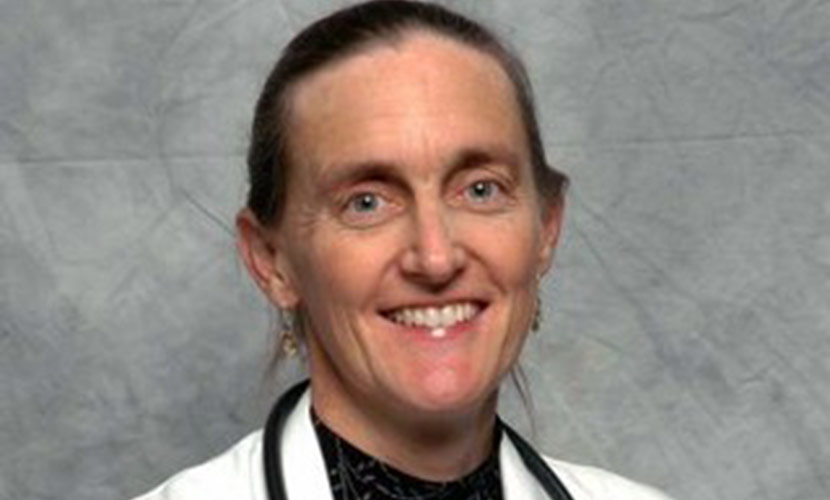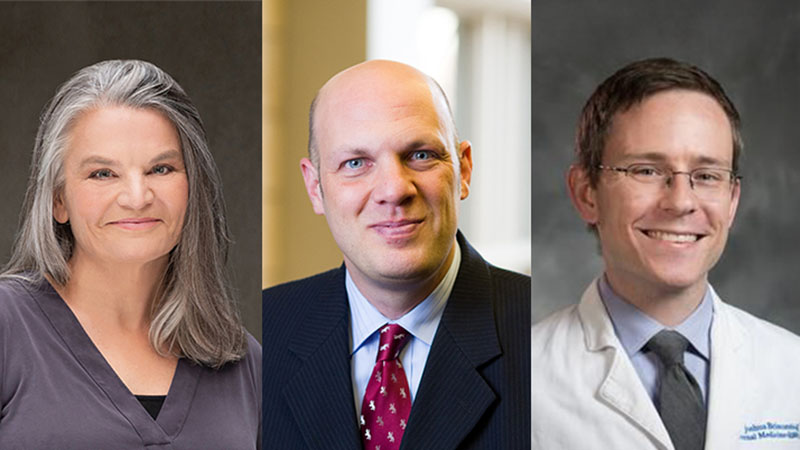
Today’s GeriPal podcast features Laura Hanson, Geriatrician and Palliative Medicine physician at the University of North Carolina, Chapel Hill. Laura discusses her recent JAMA RCT of a goals of care intervention for nursing home residents with advanced dementia.
Here is a link to the decision aid, including video.
Key excerpts from the podcast:
Laura: That is followed by an in-person discussion. I want to emphasize that, because I think that a video decision aid alone without anchoring to the clinicians who are actually delivering care is not going to be as powerful.
We did have a number of family caregivers who said, “I can’t choose between function and comfort.” That, I think, tells us something about what families want from us and what they’re hoping for for the care of somebody with late stage dementia. It allows us to think about the things that we do that might actually cause functional deterioration, like overmedication, or prolonged hospitalization with time in bed that then can turn around and result in a functional impairment that otherwise wouldn’t have occurred. I take that to heart as a clinician.
We conducted this study in a time period and in a location when population health was not a priority. It’s important to recognize that moving forward with the emergence of population health and with new quality standards for nursing homes that will penalize them for readmissions, as well as hospitals. This is a high risk, high transfer population, and there may be new incentives for physicians to become more involved in, at least, the transitional care of this advanced dementia population.
Enjoy!
By: Alex Smith, @AlexSmithMD
Eric: Welcome to the GeriPal Podcast. This is Eric Widera.
Alex: This is Alex
Smith.
Eric: Alex, who is our guest today?
Alex: Today, we have Laura
Hanson, who is Professor of Geriatric Medicine and Palliative Care at the University of North
Carolina, Chapel Hill. Welcome to the GeriPal PodCast, Laura.
Laura : It is
an honor to be here in this beautiful place.
Alex: Laura, we usually ask our
guests to start off with a song. Do you have a request?
Laura : I have a
planted request for Carolina In My Mind.
Alex: Planted!
Eric:
We would never …
Alex: We’d never …
Eric: Never!
Alex: Never, never. For our listeners, let’s just be clear, that’s fake news! Maybe …
Alex: Maybe there was some discussion.
Laura : Let’s be fair. One of
my favorite songs when I’m traveling away from home.
Alex: That’s good. Carolina
In My Mind by James Taylor.
Alex, Ericand Laura sing “Carolina in My Mind” by
James Taylor.
Alex: Nice!
Laura : Thank you.
Alex:
That’s great. I think you’re the second guest to sing along.
Eric: Yeah.
Alex: That’s great. We admire your courage.
Laura : Oh, I thought
it was a requirement.
Alex: No, no. It should be. Maybe going forward.
Eric: We only tell people after.
Laura : Oh, got it, got it.
Alex:
Today, we’re going to talk about the study that you published in JAMA. I think this came out
online last year, but in print this year, is that right? Something like that. Published
online November 28th, but post … Anyway, this really terrific study in JAMA, “Effect of
Goals of Care Intervention for Advanced Dementia, Randomized Clinical Trial.” To dive into
this study, maybe first, could you tell us a little bit about why there was a need for a
study like this?
Laura : Interestingly, the idea for this study came out of a
previous study that I did, trying to address decision making about feeding in advanced
dementia. When we did that study, where we were talking about a specific issue in advanced
dementia, a lot of the people that we worked with, family caregivers and nursing home care
providers said, “Please, do something about goals of care, because we can’t really talk about
feeding options, if we’re not talking about the big picture.”
Eric: What did you
do in the study?
Laura : In this study, what we did was spend a huge amount of
time in nursing homes with family caregivers and with people with advanced dementia. We
identified a group of nursing homes in North Carolina that were willing to let us come in and
do research there. We randomized those nursing homes into intervention and control sites. The
intervention sites got a video decision aid about goals of care in advanced dementia,
followed by a structured care plan meeting with the nursing home staff and the family
caregiver, to talk about goals of care and how it might affect the treatment plan. In the
control sites, we had a control video and a regular care plan process.
Alex: I
want to dive into this idea of this video intervention a little bit more, because I think
this is fascinating. There wasn’t, I think, a whole lot of detail, as you’d imagine, in the
written text about what that video intervention was about. You described what it was about,
but there wasn’t a lot of meat on the bones about what is this intervention? Could you tell
us a little bit more about what the intervention consisted of?
Laura : Sure.
We tried to create a technological intervention that would work in nursing homes. For those
of you who don’t work in a nursing home environment, this is an environment where Wi-Fi is
not available. This is an environment where many healthcare providers, especially people like
nursing assistants or frontline nurses are told, “Don’t get on the computers.”
What we did was develop a short, 18 minute video that could be delivered on several different
platforms, so that it would be flexible enough to be available in the nursing home setting.
In that video, we talk about what dementia is. We talk about what goals of care are. We talk
about how choosing a goal of care is essential to frame a treatment plan. We tell three
stories. We have three stories about three people with advanced dementia whose families chose
a different goal in order to guide care and how those stories unfold.
Then
we also talk about the role of the family decision maker for whom this video is really
intended, and the challenges that they might face as they attempt to speak in the voice of
the person with dementia in making these hard choices. That is followed by an in-person
discussion. I want to emphasize that, because I think that a video decision aid alone without
anchoring to the clinicians who are actually delivering care is not going to be as
powerful.
Alex: Right. That’s so helpful to have a clear picture there of
what the content of the video is. When you say, “There are three stories,” I could image that
one would be a comfort-oriented approach, exclusively. One might be some sort of limited
interventions, and one might be focused on prolonging life as much as possible. Is that the
idea of the three different pathways there?
Laura : That’s, basically, the idea,
except for that middle pathway, which some people call limited intervention, and for those of
you who use a POLST paradigm, that’s often the language that’s used. We found that language
when we were developing the video to be too negative. It sounds like taking away, which is
something that I have learned not to do in decision making with family caregivers. Instead,
we described that middle pathway as a focus on function. Being lest concerned about life
prolongation, perhaps somewhat less concerned about comfort, but concerned about supporting
the function of the person with dementia.
Eric: I had a chance to actually
watch the video and the way it’s presented, the middle one, the function one sounded quite
reasonable …
Laura : Attractive?
Eric: … for most people,
including potentially those who want to focus more on comfort. You can imagine that it’s
attractive. “Oh yeah, I’d love to see my loved one regain some function.” For people with
advanced dementia, how realistic is that pathway? What did people actually choose?
Laura : Interestingly … I appreciate your characterization of that middle pathway,
and I do think that there are a lot of families who are interested in something like a middle
pathway for dementia care, but the reality is that two thirds of these families chose comfort
right upfront. They chose comfort as their top priority. By the end of the study, it was a
significantly higher number, more than three quarters choosing comfort as their top
priority.
We did have a number of family caregivers who said, “I can’t choose
between function and comfort.” That, I think, tells us something about what families want
from us and what they’re hoping for for the care of somebody with late stage dementia. It
allows us to think about the things that we do that might actually cause functional
deterioration, like overmedication, or prolonged hospitalization with time in bed that then
can turn around and result in a functional impairment that otherwise wouldn’t have occurred.
I take that to heart as a clinician.
Alex: I wonder for our listeners, is it
possible to view this video?
Laura : It is.
Alex: Is it available
online?
Laura : It is. This was developed with your tax dollars and is freely
available. It’s currently available on the UNC Palliative Care website. People can look at it
there. It’s available on Vimeo, you can just search Dementia Goals of Care. It’s available,
or it will be available, I should say, it’s going through the clearing process now on the
Ottawa Health Research Institute website. That is the largest clearinghouse for decision aids
anywhere in the world.
Alex: We’ll have a link on the GeriPal Podcast to the
video. The decision aid … the structured interview or what happens after the video, is that
available?
Laura : That will be available. It is going through the Ottawa
process. Once it goes through the Ottawa process, it will be posted on their website. It’s a
guide for a structured decision that, when you do see it, you will think is quite simplistic,
but basically asks that the conversation begin with a description of the person with dementia
themselves and the family’s understanding of their health state. Then a discussion of the
goals options, followed by a discussion of the implications for treatment plans, so fairly
straightforward.
Eric: Did it work?
Laura : We think it did. The
intervention was very exciting to deliver, very engaged family caregivers with it. I take
that to heart, because it has be acceptable and interesting for them. Basically, what we
found in terms of the outcomes, our primary outcomes were focused on the quality of
communication and decision making itself. No matter what is chosen, is the experience of
communication improved by this intervention? The families said that it was. That overall, the
families with the intervention experienced a better quality of communication with nursing
home providers, and specifically experienced better quality of communication about end of
life concerns.
The families in the intervention group also felt that they
and the nursing home staff were in stronger agreement on the primary goal of care that was
guiding the treatment plan, which is helpful. It impressed me, because there were still, in
the control group, a significant group of people who felt that they weren’t on the same page.
That’s pretty poignant to feel about someone you love who’s being cared for in a nursing
home.
We also found some downstream effects of it. Some of them surprising.
Some secondary outcomes that we didn’t particularly expect to affect. One was that we saw in
the chart reviews, there was actually more palliative care content to the treatment plans for
the intervention group, so the nursing home staff actually did more in modifying treatment
plans than we expected.
Alex: What was included in the palliative care
content?
Laura : Palliative care content for us, which is something that I had to
develop a measure for, is asking if 10 different domains of palliative care are addressed
anywhere in the treatment plan. Five of those domains are specific treatment decisions that
are relevant to dementia care and five are domains of palliative care, like physical symptom
management, emotional distress management, spiritual caregiving. We saw an increase in that
content.
The more downstream consequences were that we saw the intervention
participants actually more frequently had a MOST form, which is our version of the POLST
completed. We’d never ever in the intervention mentioned POLST. We gave no instructions in
that realm, but the goals of care decision aid fairly easily tracks. We had a number of the
nursing home staff who were in the intervention sites say, “Hey, we could use this in order
to complete MOST forms with families.” Then we also saw a reduction in hospitalization for
this population with the intervention, which again, we didn’t particularly expect, but we’re
excited to see.
Alex: And yet, when Ericasked, “Did it work?” You said, “We
think it did.” Are there some aspects in which the study surprised you and ways in which it
didn’t work?
Laura : Some of the things that were not affected by the intervention
were in the areas of general satisfaction with care and the management of symptom distress.
When we asked families, “If either of those things changed or improved with the intervention,
we didn’t see anything.” That lack of effect is something that I’m now thinking about a lot
in research moving forward. Thinking really seriously about how we can help people who have
advanced dementia actually experience better comfort and experience better care for symptom
distress. I think that’s an area that’s really untapped in dementia care.
Eric:
Who was actually involved in these conversations? Because in many nursing homes, physicians
are not often present.
Laura : That was true here. The leadership in nursing
homes is just what it sounds like. It’s nurses. Nurses, very typically, led these
conversations, and social workers were not far behind, very much involved. It’s very
powerful, if a nursing facility also has an advanced practice provider, so a nurse
practitioner, or a physician assistant who’s on site. If they were, they would typically be
involved, but that’s the minority of nursing facilities.
Physicians, I’m sad
to say, were absent. We could not, despite a concerted effort in the study protocol, to
notify physicians when their families were participants, to notify physicians when these
meetings were taking place. I have to say I know some of these physicians personally, but for
them this is outside that standard of practice so far that it was not possible to change
that. We didn’t predicate the intervention on physician participation, but that is another
area for our future work. Thinking about how physicians can become more involved.
Eric: Were they involved in the most sightings?
Laura : Yes.
Eric:
Somehow this got back to them.
Laura : That is correct. That’s often how
nursing home care works, where nurses are frontline. If nurse practitioners or PA’s are
available, they’re also frontline. Decision making takes place and physicians back that
decision making up.
Alex: Reminds me of hospice. Nurses, frontline say, “I need
this medication, can you sign these prescriptions?” Yes, doctor signs them. They’re back line
on the front lines. It’s interesting, because there’s two sides to the physician involvement
piece here. On the one hand, they weren’t involved, and there may be opportunity for an even
bigger effect, if they were involved and were able to communicate effectively.
On the other hand, this is real world, because most physicians aren’t involved in nursing
homes. If you had all of your physicians gangbuster involved, then it might have raised
questions about how generalizable is the study? Maybe these are some handpicked academic
affiliated nursing homes, or something that are quite different from other nursing homes
around the country. There’s some interesting angles to that aspect.
Laura : That
is true. We designed it to be delivered in real world settings and these are not academically
affiliated nursing homes, for the most part. They represent a very typical spectrum of
nursing homes from some that are exceptional and have a strong investment in dementia care,
to many that are very typical, ordinary nursing homes and match national standards, but don’t
go above that.
I do want to mention one other thing about the physician
involvement, though, that’s interesting to think about for the future. We conducted this
study in a time period and in a location when population health was not a priority. It’s
important to recognize that moving forward with the emergence of population health and with
new quality standards for nursing homes that will penalize them for readmissions, as well as
hospitals. This is a high risk, high transfer population, and there may be new incentives for
physicians to become more involved in, at least, the transitional care of this advanced
dementia population.
Eric: I can imagine that brings up that tension, as far as
what outcomes we should be looking at. Your primary outcome what the quality of
communication. I think, for healthcare systems, what they’re probably more interested in is
potentially satisfaction, but realistically transfers to the hospital care that is expensive
and may not offer a whole lot of benefit to individuals with advanced dementia. How should we
think of when we’re looking at these studies, what outcomes are the most important to look
at?
Laura : Wasn’t it nice that we had an impact on several different outcomes?
That was helpful. That being said, I have chosen to put shared decision making front and
center. I think that’s really essential for people who do research in this area, as well as
for people working in clinical practice with people who have later stage dementia. If we
don’t get the shared decision making right, we cannot impact hospitalization, at least not in
a way that’s healthy and sustainable. Because if we don’t get the shared decision making
right, then what we’re doing is simply working out a mechanism to, apparently, take something
away from people with advanced dementia.
I would argue that the real goal is
to anchor the care of people with advanced dementia in nursing homes with higher and higher
quality care there, so that the idea of an emergency department as the only source of relief
from distress is eliminated from the repertoire. Shared decision making has to take place
first, before those kinds of choices can be meaningfully made. It’s not to say it’s the only
outcome that matters, but it has to be part of the package.
Eric: This is
terrific. Taking a step back, bigger picture. What do you think is the direction that nursing
homes need to move in order to make a palliative approach to care the standard approach in
nursing homes for residents with dementia? If you agree with that statement.
Laura
: I do agree with that statement. My wishlist is very long.
Eric:
Right.
Laura : I’m a little worried about my answer running over time for
this podcast. I think one of the most essential priorities … and I just mentioned this, is
to enrich the nursing home environment itself, which is both the home and the primary source
of healthcare for most people with late stage dementia in the U.S. To enrich that environment
with palliative care expertise. There are a lot of different ways that we might think about
doing that. One way is to have palliative care consultation that’s robust and readily
accessible in that environment. Very few places anywhere in the United States have that yet,
but there are places that are working on that.
Another way to do that is to
make palliative care quality metrics more of a focus for how nursing home providers are
rewarded and supported. Some of that’s starting to occur, as well. Then the third way to do
it is to think about really lifting the skillset in the nursing home staffing profile, so
that can be done through training, although that’s fraught, because the staff turnover rates
in many nursing homes are well above 50% per year.
Eric: Wow, that’s high.
Laura : It’s really … it means that education, literally, exits the building.
Eric: Yeah.
Laura : Training built with systems changes may be
successful. I think more viable is to actually place a higher level practitioner in that
environment. There’s a good amount of research that says, when advanced practice providers
are available, people who can do advanced care planning, who can do more skilled medical
assessment and who can do prognostication, which is unique to advanced practice providers and
physicians, you get a lot of the outcomes that you want.
Eric: Yeah.
Alex: Let’s say I’m a nursing home, I’m listening to this podcast and I really want
to try out this video. Do I have to wait for the Ottawa …
Laura : No. No.
Alex: Give me a couple of steps of what I could do.
Laura : Yeah,
a couple of options. One is to use it directly off of Vimeo right now. That’s perfectly fine
and available. Another is that people can contact me directly, and because of the difficulty
of delivery of even video across the internet in nursing homes, I’m happy to send … oh,
this sounds so old-fashioned, a CD-ROM, a DVD, a paper copy.
Alex: Betamax.
Laura : Exactly. Exactly. Because that may be, frankly, what education specialists in
nursing homes need in order to be able to use this material, and we’re happy to provide
it.
Alex: Wonderful.
Eric: That’s great. Did you work with the
other folks who are making advanced care planning videos around the country, like Angelo
Volandes?
Laura : I am doing some work with Angelo now, but I didn’t at the
beginning of this project. The interesting thing really is the technological limitations in
nursing homes and wanting something that was very low cost, very low health literacy, which
is very important in the research environment. It’s another long discussion, but basically,
in the nursing home environment, you need to pay a lot of attention to low health literacy in
order to be successful, and wanting something that can be developed in a way that it could be
delivered in this very simple way. Yeah, now Angelo and I are collaborating and doing some
work together, which is exciting.
Alex: What’s the next step for this
research?
Laura : What we’re doing now is actually taking to heart some of the
failed outcomes, the area of lack of effect on symptom distress. I’m working on a model
project of dementia palliative care for individuals with late stage dementia who land in the
hospital. We’re testing that model to see if we can have some impact on some of the outcomes
that we were not able to affect when we focused exclusively on goals of care as our primary
intervention.
Eric: Great.
Alex: Great.
Eric: Any other
questions?
Alex: Should we have another verse?
Eric: That sounds
wonderful.
Alex: Let’s do the one with the word dying in it.
Alex, Eric and Laura sing “Carolina in My Mind” by James Taylor.
Produced by: Sean Lang-Brown



